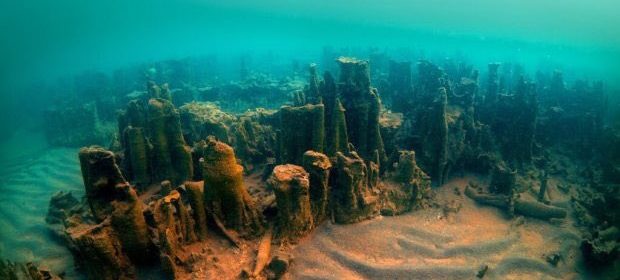Ruins of a 3000-year-old Armenian castle found in Lake Van – Turkey

Ruins of a 3000-year-old Armenian castle found in Lake Van – Turkey
The remains of an ancient fortification, 3,000 years old, have been discovered at the bottom of Turkey ‘s largest lake. Divers exploring Lake Van have uncovered the tremendously well-preserved wall of a castle, which the Urartu civilization thought to have been built.
Experts had been studying the water body for a decade before revealing that the fortress was lost deep under its surface.
The discovery was made by a team of researchers, including Tahsin Ceylan, an underwater photographer and videographer, Cumali Birol diver, and Mustafa Akkuş from the University of Van Yüzüncü Yıl University.
Legends among the population of the area talked about ancient ruins hidden in the water, and the team of van decided to investigate. Over the course of 10 years, they captured pictures of pearl mullets, microbialites, corals, and even a sunken Russian ship, but their prize remained elusive.
There search has now paid off, uncovering castle stonework that has been protected from the ravages of time by the lake’s highly alkaline waters.
It is thought the stone structure was built by the Urartians, as the rocks used were favoured by the civilisation.


The castle, as well as a number of villages and settlements in the area, were built at a time when water levels were much lower than they are today.
Speaking to Hurriyet Daily News, Mr Ceylan said: ‘Many civilisations and people had settled around Lake Van. ‘They named the lake the “upper sea” and believed it hid many mysterious things.
‘With this belief in mind, we are working to reveal the lake’s secrets. ‘It is a miracle to find this castle underwater.’
The Kingdom of Urartu was ancient country in the mountainous region southeast of the Black Sea and southwest of the Caspian Sea. Today the region is divided among Armenia, eastern Turkey and northwestern Iran.
Mentioned in Assyrian sources from the early 13th century BC, Urartu enjoyed considerable political power in the Middle East in the 9th and 8th centuries BC. The Urartians were succeeded in the area in the 6th century BC by the Armenians.
Urartu is an Assyrian name and the people called Urartians called their country Biainili. Their capital Tushpa, was located at what is now known as Lake Van.
Most remains of Urartian settlements are found between four lakes: Çildir and Van in Turkey, Urmia in Iran, and Sevan in Armenia, with a sparser extension westward to the Euphrates River.

KINGDOM OF URARTU
The Kingdom of Urartu was an ancient country in the mountainous region southeast of the Black Sea and southwest of the Caspian Sea. Today the region is divided among Armenia, eastern Turkey and northwestern Iran.
Mentioned in Assyrian sources from the early 13th century BC, Urartu enjoyed considerable political power in the Middle East in the 9th and 8th centuries BC. The Urartians were succeeded in the area in the 6th century BC by the Armenians.
Urartu is an Assyrian name and the people called Urartians called their country Biainili. Their capital Tushpa, was located at what is now known as Lake Van.
Most remains of Urartian settlements are found between four lakes: Çildir and Van in Turkey, Urmia in Iran, and Sevan in Armenia, with a sparser extension westward to the Euphrates River.
Subscribe to our newsletter!